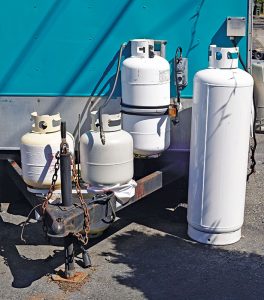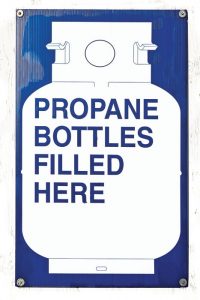Providing for the safety of customers

Employees need to know they are being tested every time they fill a propane cylinder. Photo: iStock.com/Joe_Potato
This is an article about a safety concern we have when it comes to the industry people most visible to consumers: propane dispenser operators. It seems that some people who operate propane dispensers either are not properly trained on how to fill cylinders, or they are ignoring their training. There have been some significant incidents that point out how things are being done wrong when it comes to filling and transporting cylinders. Let’s take a look at several examples of training or attitude concerns that occurred during a period of only 15 months.
In July 2014, an incident occurred in Philadelphia that received national attention, at least among enforcement officials. A 100-pound cylinder on the back of a food truck came apart and ignited, killing two people and injuring about a dozen. The cylinder was about 64 years old and had never been requalified. That’s 52 years beyond its qualification expiration of improper filling! Any person filling it in those 52 years could have looked it over before filling it and decided that it needed to be taken out of service or requalified before it was filled, especially as it must have degraded in the last 10 years or so. Think about how many opportunities existed for taking the cylinder out of service before that fateful day. The U.S. Department of Transportation (DOT) is still investigating the incident, so no conclusions are available yet, but, reading between the lines, I expect that DOT is preparing to cite the last filler and/or supplier, possibly for criminal charges.
Another incident occurred in early 2015 when one of our inspectors observed a person improperly filling a cylinder. When he confronted the individual about his actions, the reply he received was, “I would have paid more attention if I had known there was going to be a test.” While this seems funny at first, it reveals an apparent lack of concern about safety when filling a cylinder. It also makes me wonder about the quality of instruction that individual received.
In North Carolina, in 2015, there were two incidents of improper filling coupled with improper transportation. In both cases the customers’ cars were totaled and one customer spent over a month in the hospital for treatment of her burns.
The first incident had several violations, which include: using a 30-pound cylinder that was beyond its qualification period; the attendant depending on an OPD, which was not present on the out-of-date cylinder, to determine when it was full; the cylinder being placed on its side in the trunk of the car; and failure by the attendant to warn the customer about promptly removing the cylinder from the vehicle. The customer went home and left the cylinder in the car. His girlfriend was driving the car a little later when the cylinder, which was still in the trunk, burst into flames.
The other incident occurred only a month later. In this case, the list of violations includes: using a 100-pound cylinder that was beyond its qualification period; the attendant filling the cylinder even though neither a screw-on cap or POL plug were present; the 100-pound cylinder being placed in a vehicle that had no separation between the cylinder and the passenger compartment, even though regulations state that the largest cylinder allowed to be in the same space as passengers is 45 pounds; and loading the cylinder into the SUV on its side.
In this case, the cylinder probably hit a seat support, or other obstruction, when it was loaded into the vehicle, which may have partially opened the valve or caused the cylinder to leak. The cap would have prevented inadvertent valve opening or a POL plug would have prevented leakage, but, as noted, neither of these were present. The leak caused the interior of the SUV to burst into flames, blowing out the windows. Luckily, this happened before the passenger got in the vehicle.
Training for filling cylinders must include several points from Chapter 7 of the “LP-Gas Code.” This chapter covers what containers are acceptable to be filled. Filling concerns consist of about three pages in the code and make up the majority of Chapter 7. Listing them all here would take too much room and you would get bored. It is, however, pertinent to point out the most common violations, which include:
- Filling out-of-date cylinders or not knowing requalification rules;
- Relying on the OPD to determine when the cylinder is filled;
- Failure to properly inspect the cylinder before filling or not removing a sleeve before filling;
- A lack of training, documentation of training or refresher training on how to properly fill a cylinder;
- And failure to provide written notification to the customer when a cylinder is found to be noncompliant.
Training must also include several points from Chapter 9, which discusses how containers are to be transported. The transportation violations we most often see are:
- Allowing the customer to load the cylinder into the vehicle unsupervised;
- Loading a cylinder into a vehicle on its side;
- Loading too large a cylinder into the passenger space;
- And failure to secure the cylinder to prevent moving or tipping.
The first of these may seem to you to be overly stringent. We don’t think so. We must assume that customers are untrained with respect to proper transportation rules. The trained person must either load, or supervise the loading of, the cylinder into the vehicle to properly execute their responsibility for proper transportation of the cylinder. Their responsibility doesn’t end until the customer drives away or leaves the premises.
Why do these violations happen? Frequent turnover of employees is one possible reason. Turnover presents a problem of keeping everyone trained. Supervisors may fail to properly train new employees because the time and expense of training a new employee cuts into productivity. Another reason may be due to the trainers themselves being inadequately trained. Subjects may be glossed over or forgotten if the trainer doesn’t have a proper training outline or plan. Training by a store manager or another employee is not likely to be good training. It is also possible that safety is not emphasized during training. Employees need to know that they are being tested every time they fill a cylinder. Also, they should realize that they are possibly in the most vulnerable position should the cylinder fail while being filled. The final reason may be that employees take shortcuts. They fail to use a bleed valve and depend on the OPD when they can’t find a screwdriver. They don’t take time to look for the manufacture date, or at the bottom of a cylinder.
We are taking these concerns seriously and are implementing new policies that will, hopefully, hold propane dispensers responsible. We used to write an inspection requiring retraining when we observed the above violations. Sometimes we would stop the filling or would not allow the customer to leave with the cylinder until the violation was corrected. Then, the individual filling the cylinder would have some time to correct their training deficiencies. Now, we write an inspection that costs them a penalty right away. This seems fair because, after all, they are subjecting the customer, or themselves, to an unsafe situation right away. It is the only way to get their attention. The requirement to provide training wasn’t making things better.
Are we seeing an improvement? I can’t say that we are yet. However, a few instant penalties have been written and no new reports of incidents have been received. We did go to a lot of effort to spread the news to the propane companies and urged them to share it with the dispenser locations they supply. The inspectors are still watching.
Richard Fredenburg is an LP gas engineer at the North Carolina Department of Agriculture and Consumer Services, Standards Division.
















